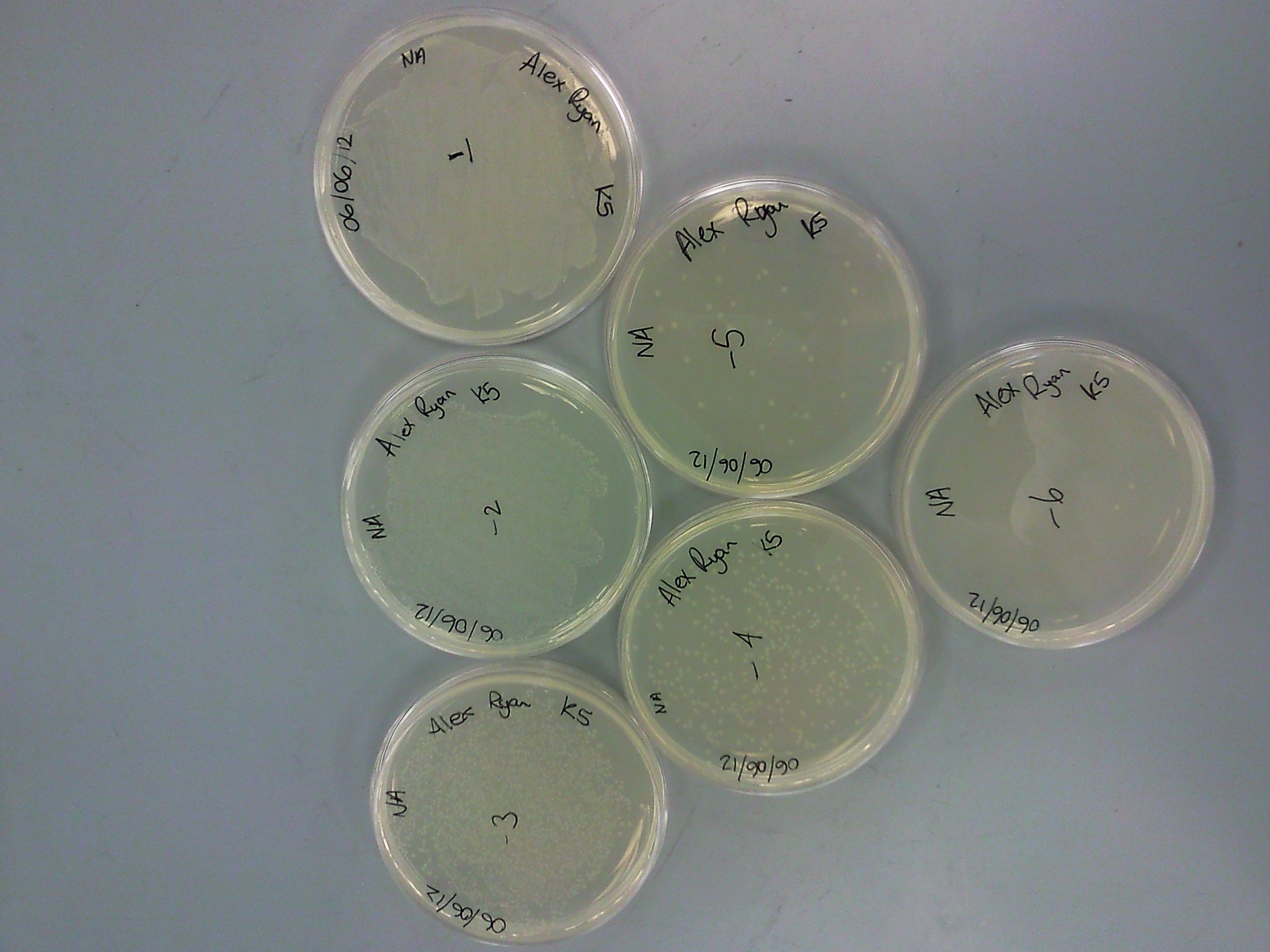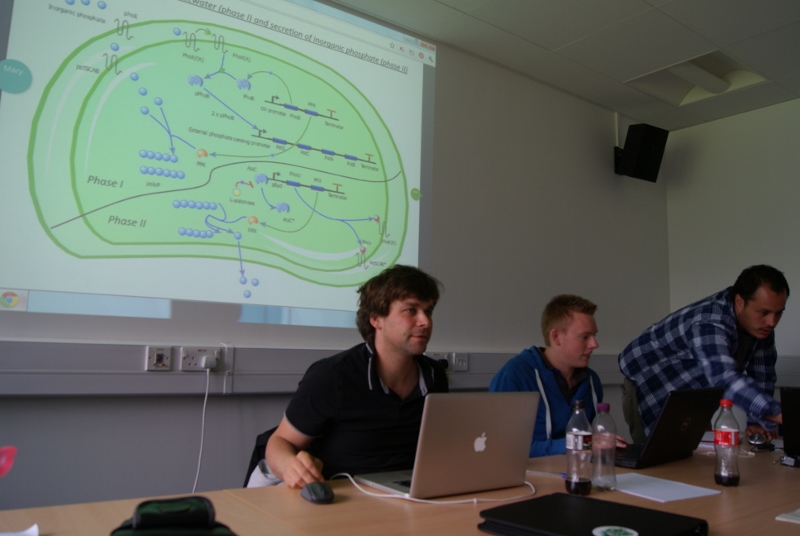Team:Exeter/Notebook
From 2012.igem.org
| Line 71: | Line 71: | ||
[[Image:DSC07469_(800x536).jpg|500px|thumb|centre|Freddy, Alex and Raf preparing for the presentation]]<br> | [[Image:DSC07469_(800x536).jpg|500px|thumb|centre|Freddy, Alex and Raf preparing for the presentation]]<br> | ||
| - | After an anonymous vote ....<big><font color = "FA8072"><b>SWEET SHOP </b><font color = "black"><small><font color=black> is our project for the summer! We're all very excited about getting started....but before then, time for a relaxing game of pool! <br><br> | + | Both ideas are especially strong and most students changed their minds multiple times before the day was up. After an anonymous vote ....<big><font color = "FA8072"><b>SWEET SHOP </b><font color = "black"><small><font color=black> is our project for the summer! We're all very excited about getting started....but before then, time for a relaxing game of pool! <br><br> |
<font color = "FA8072"><big><big>'''WEEK FOUR'''</big></big><font color = "black"> | <font color = "FA8072"><big><big>'''WEEK FOUR'''</big></big><font color = "black"> | ||
Revision as of 14:55, 27 June 2012
| Home | Team | Official Team Profile | Project | Parts Submitted to the Registry | Modeling | Notebook | Safety | Attributions |
|---|
The story so far...
The first three weeks of the project have been set aside to obtain a general biological background, particularly useful for the non-biologists in the team! This will be achieved through several short lectures, discussions and practical laboratory sessions. Project ideas will be put forward with the aim of making the final decision on Thursday 14th June. The subsequent ten weeks are set aside for the project to be developed.
WEEK ONE
28th May 2012
The team arrived and Tom (the project coordinator) started us off with an introduction to the iGEM competition, shortly followed by John Love giving a talk on synthetic biology. Tom got everyone up to scratch on basic biology (central dogma etc). Orkun Soyer (mathematician) gave a talk on biostability and then Christine Sambles gave an overview of the -omics.
29th May
Clive Butler talked about Thauera selenatis and microbial nano-material synthesis. Nick Smirnoff spoke on metabolic engineering and then Nic Harmer on polysaccharides. The afternoon session was set aside for brainstorming.
1st June
Today's lecturers:
- Tom- biofuel production.
- George Littlejohn- biosensors and reporters.
- Rob Beardmore (Biosciences)-dynamical systems modelling.
- Peter Petrov (Physics) - bacterial swimming and artificial swimmers.
The afternoon session was spent brainstorming, below are a selection of some of the ideas:
WEEK TWO
6th June
Initial lab induction with an in depth health and safety talk. Basic lab techniques were practiced, such as gel preparation and creating single colonies, see photograph insert for the very respectable results from a Physicist!
7th June
The second day of lab work- we isolated the DNA and then separated the DNA fragments using Gel Electrophoresis. The estimated sizes were then mapped and compared to expected maps.
8th June
Through many hours of brainstorming and discussion over the past two weeks the team has managed to single out a short-list of five strong ideas for the project which were presented to a range of relevant academics.
- Phosphate Collection- through synthetically modifying an organism the uptake of phosphates may be significantly increased.
- Polysaccharide synthesis - designer sugars. Creating a biological toolkit with which houses many material and medical applications.
- One-cell cellulose degradation - 'pac-man'. Find commonality for three types of cellulases and affix to scaffold. Could have transfer sequence to cell exterior.
- Logic-gated 'thinking' bacteria - improve on what has already been done somehow. Should work at level of proteins, not genes, for instant response.
- Biological ionising radiation detector- a method of detecting the strength of Gamma, X-ray and UV waves through their energy output.
After further discussion, two ideas were taken forward to next week...Polysaccharide synthesis and Phosphate Collection.
WEEK THREE
11th-15th June
Throughout the week we've all been super busy researching for the final presentation of our two ideas. We had to get our designs up to scratch for the scrutiny of a range of professors and researchers who really know their stuff! Our two final ideas:
- Phosphantastic- Phosphate supplied are going to deplete within 30 years, and with 2/3rd of the world population relying directly upon Phosphate-based fertiliser... we feel it is a very important issue to tackle. The premise being through Synthetic modification we can create a two phase process where by the cell, in response to a promoter, uptakes way more Phosphate than would naturally occur. The second phase looks at excreting the phosphate ready for collection.
- Sweet Shop- A Polysaccharide catalogue which will eventually allow designer materials to be created, for example a polymer with strength x which yields at y. This idea, albeit a colossal challenge, if successful will change the outlook on Synthetic Biology and Materials Engineering.
Both ideas are especially strong and most students changed their minds multiple times before the day was up. After an anonymous vote ....SWEET SHOP is our project for the summer! We're all very excited about getting started....but before then, time for a relaxing game of pool!
WEEK FOUR
18th-22nd June
Project planning began with a huge whiteboard and tonnes of enthusiasm. It's a tall order to try and organise a ten week project between ten students from different backgrounds, but we're working on it!
A few of the group members began by developing their coding knowledge and started working on the wiki page. It was amazing to see that within a few days so much could visually change for the project. Through meeting a graphic designer, we created a new logo and re-branded our project with the new name, E-Candi. "
Taking care not to neglect the science,
Modelling began
WEEK FIVE
 "
"


